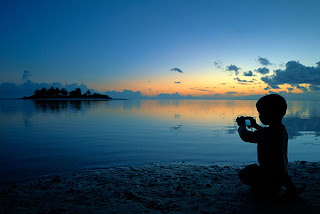Get The Lighting And White Balance Right. Lighting is much more important to digital cameras than to film cameras. If your digital camera has settings for different lighting conditions, such as daylight, cloudy, fluorescent, incandescent, make sure you use them—it can make or break your pictures. Never aim a digital camera at a light source (unless it’s a sunset or candles). Make sure that bright lamps, sunshine, glare, etc. are out of the frame.
Use a flash for indoor shots and dim outdoor lighting. If the flash is too bright, lower the intensity a couple of f-stops, or use a homemade diffuser by placing a one-ply tissue over the flash.
Be Sure To Get Close Enough. One of the biggest reasons digital pictures look bad is because they were taken from too far away. Avoid vast expanses of boring “dead” space (like the walls, ceiling, grass, pavement). Move in and get close to your subject. Fill the frame with the scene, the people, or the faces you want and leave the background out.
Reduce Red-Eye. It’s almost impossible to completely eliminate red eye with a pocket or compact digital camera. But it can be reduced by using the “Portrait” setting, turning up the house lights, and having the subject face the light while turning slightly away from the flash. If all else fails, use image-editing software to remove red-eye.
Compose Your Pictures. Before pressing the shutter, take a quick, objective look at the composition and background. If there’s clutter, distraction or a confusing subject, make changes before taking the picture.
Steady The Camera. Prevent “camera shake,” by using a wall, table or tripod to hold the camera steady, especially at night. And be sure to wait until the camera completes the shot before you put the camera down. It can take 5 seconds or longer if the light is low.
Be Prepared For Shutter Lag. Digital cameras are really small computers—they require time to capture the scene. Plan ahead when shooting people and especially children or your two-year-old’s smile could be a scowl by the time the shutter snaps. Anticipate the perfect moment and press the shutter just before it happens. It’s tough to do, but with practice, you get better at it.
Use High Resolution. High resolution and low compression produce smoother and more detailed images. For best results, get 3.2 MP or higher and use the highest resolution for important pictures you plan to print.
Have Battery Backups And Extra Storage On Hand. Running out of batteries or room on your storage card puts a quick end to your photo fun. Be prepared with spare batteries and another memory card so nothing puts a damper on your holiday memories.
Source: premierphotographer.com
Below are some amazing holiday shots:
Flickr Paul (dex)
Flickr Steve-h
Flickr macieklew
Flickr muha...




No comments:
Post a Comment